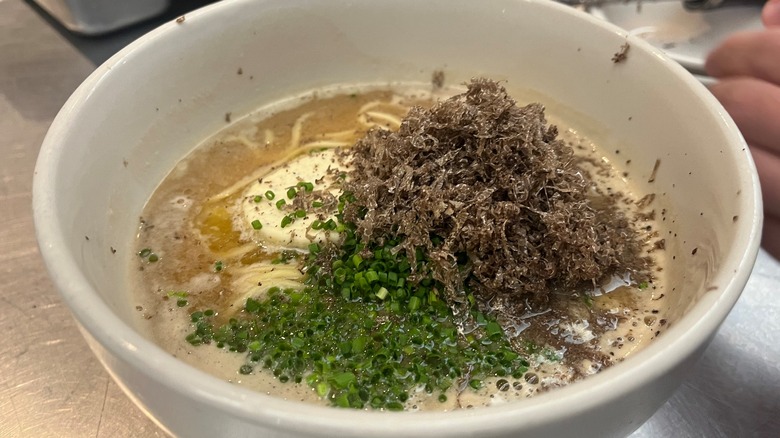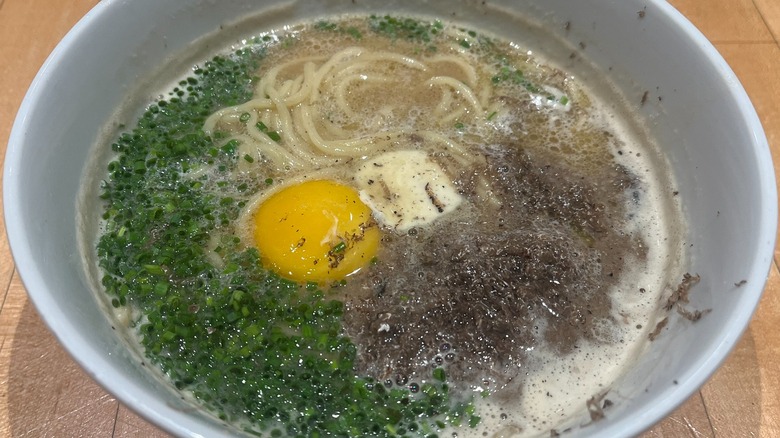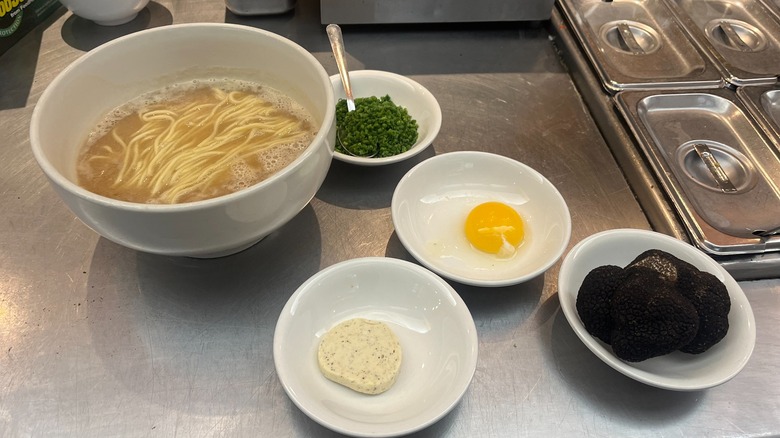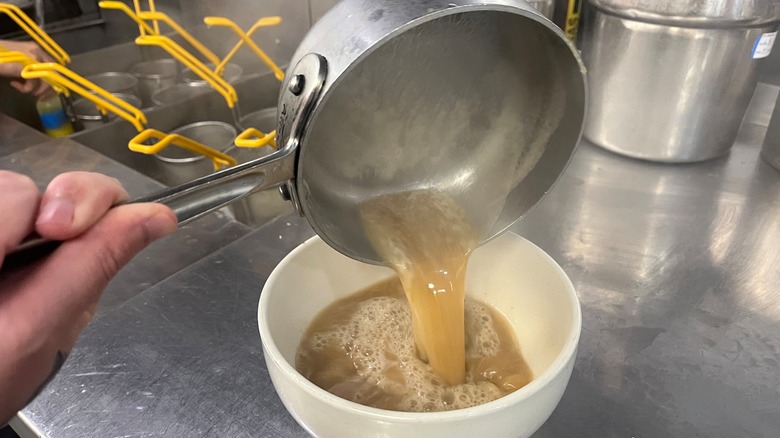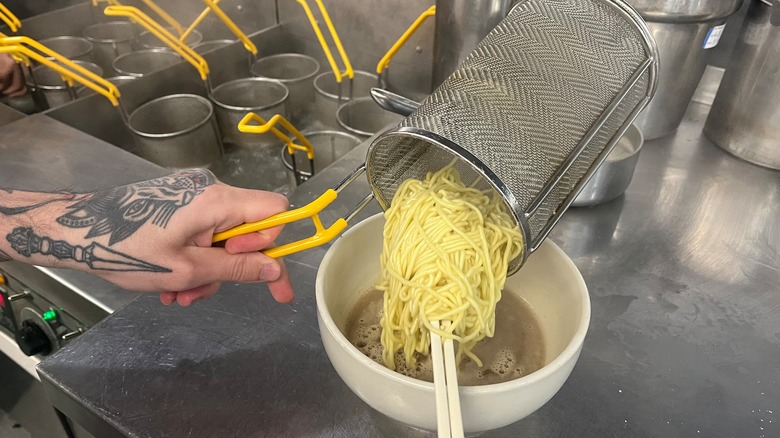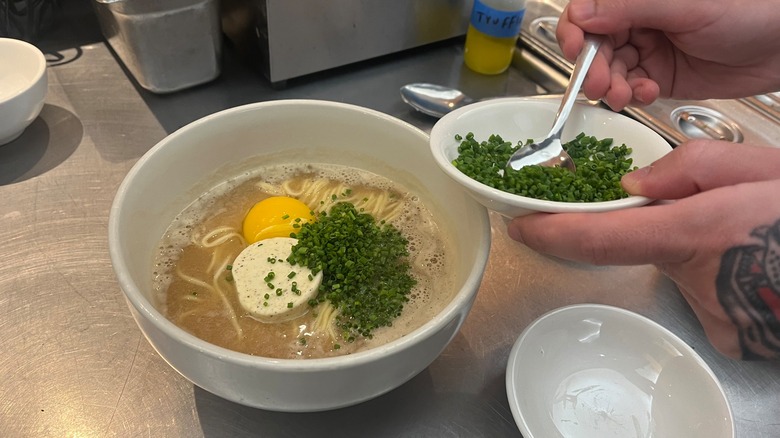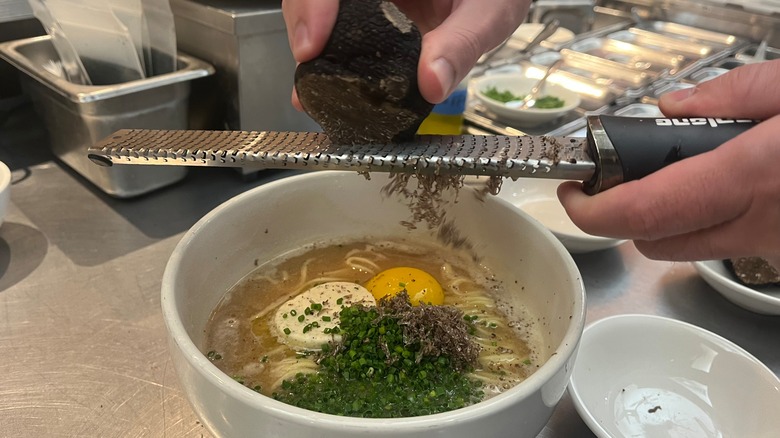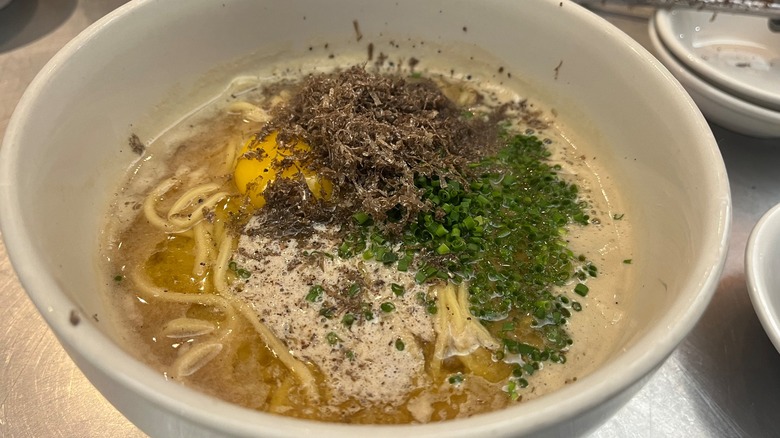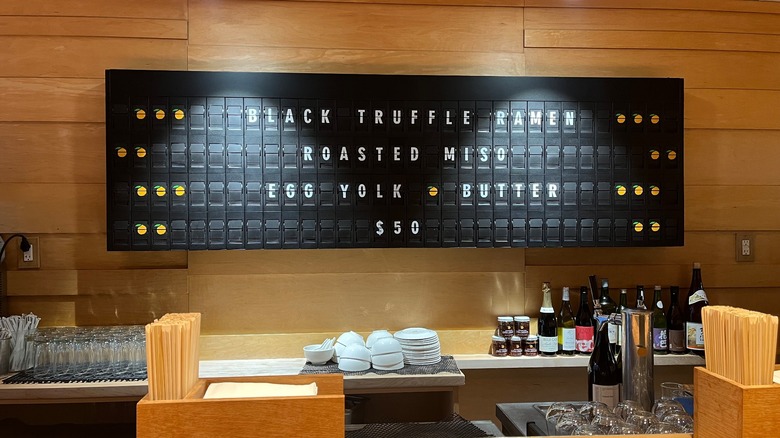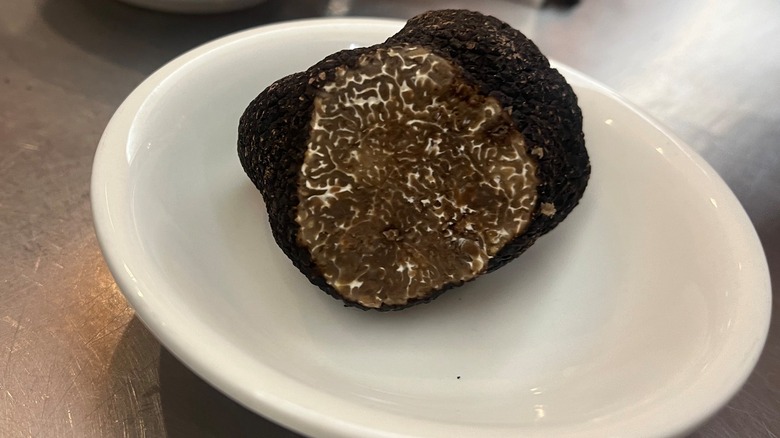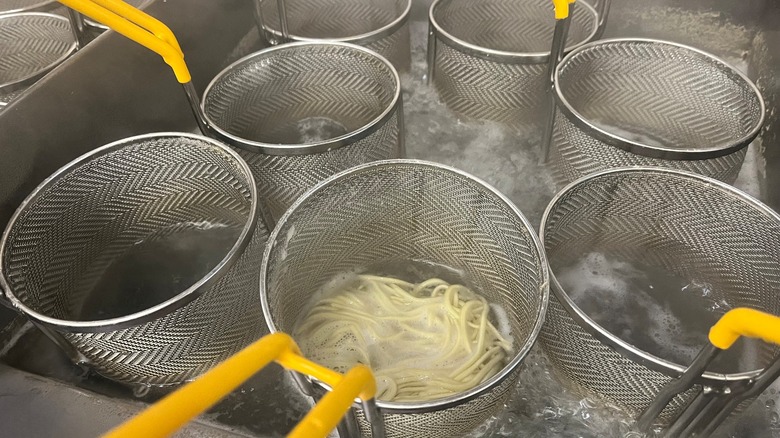How Momofuku Prepares Its Decadent Truffle Ramen - Exclusive
Calling all ramen enthusiasts. We have the update you've been waiting for. Momofuku's famed Truffle Ramen is back on the menu for a limited run this winter season at Momofuku Noodle Bar in New York's East Village and its Uptown location. To celebrate the return of this savory, decadent bowl of truffle goodness, we went behind the counter of the open kitchen with chef de cuisine of Noodle Bar East Village, Pablo Vidal Saioro, to hear about the origins of the fan-favorite dish and to learn how it's made.
While several Momofuku locations closed in 2020 as a consequence of the pandemic, Noodle Bar retains a sacred spot, particularly in the East Village, as one of the premier restaurants in New York City for diners seeking bowls of ramen. Our visit took place in between the lunch and dinner service, giving us the rare opportunity to experience the restaurant without the vibrant hustle and bustle it's known for. During chef Vidal Saioro's ramen demonstration, he shared tips for preparing ramen at home as well as the most common mistakes he sees folks make in the kitchen when cooking with truffles and noodles.
The inspiration behind Momofuku's Truffle Ramen
We have David Chang's famed Momofuku fried chicken and caviar to thank for the inception of Momofuku's truffle ramen. Almost a decade ago, Momofuku partnered with Regalis, a US specialty food company that is based in Idaho, to showcase some of the world's best caviar with Chang's signature fried chicken. Momofuku's truffle ramen was born when Regalis sent the restaurant a shipment of its exceptionally high-quality black truffles. Upon receiving the truffles, chef Vidal Saioro recalls, "We're, like, let's do something with [them]."
That something took the form of a bowl of ramen that is relatively stripped back, compared to several other ramen dishes at the restaurant, to let the flavor and decadence of the black truffle take centerstage. Nine years later, Momofuku's truffle ramen is a seasonal favorite that embodies all that Momofuku is known for — first-rate ingredients, perfectly cooked fresh noodles, and a sumptuously savory broth.
What's in the truffle ramen?
So what's in the truffle ramen? The dish is composed of a short but elevated list of fresh, high-quality ingredients. The bowl starts with Momofuku's signature ramen noodles, which are tossed in a savory roasted miso broth before being topped with a generous portion of freshly snipped chives, a disc of wildly rich compound truffle butter, a perfectly gooey egg yolk, and 10 grams of shaved Burgundy black truffle.
Welcome news for folks following a plant-based diet is that Momofuku's truffle ramen is entirely vegetarian. That decision is neither accidental nor inspired by the trend of vegetable-forward lifestyles that are increasingly common these days. Instead, it's a choice that was made to highlight the dish's core ingredients and ensure they aren't overpowered. According to chef Vidal Saioro, rather than using a protein-based broth, which is the case for many ramen dishes at Momofuku Noodle Bar and ramen spots elsewhere, "for this bowl we focus 100% on the truffle flavor...you have maybe two or three [other] ingredients in the bowl, and that's all we need."
Mise en place
When preparing ramen at home or a restaurant, one of the most important practices in the kitchen is to ensure that all of your ingredients are fully prepped before you begin cooking. This step is called mise en place, which is a French term that translates roughly to "putting in place" or "gathering." The reason this step is essential is because texture is key when making excellent ramen noodles.
Allowing the noodles to spend too much time in the broth before adding the additional ingredients may result in the noodles becoming gummy or chewy before serving. Additionally, for ingredients such as the compound butter and the raw egg yolk, the moment those enter the broth, the butter will begin melting, and the yolk may break, gushing deliciously into the bowl. That's the perfect time to start enjoying your ramen, but if you haven't pre-snipped the chives or located the kitchen tool you'll use to shave the black truffle, then the bowl will sit on the counter, and the flavors will change dramatically.
Momofuku takes this cooking guidance incredibly seriously. After the kitchen demonstration was finished, instead of offering the bowl of ramen that he just prepared, chef Vidal Saioro insisted on making a fresh one.
Prepare the roasted miso broth
Once your ingredients are prepped, you can begin cooking your roasted miso broth. At Momofuku Noodle Bar, the roasted miso broth was designed specially for the truffle ramen and is available only for that one dish. The flavor pairing of miso and truffle is one that chef Vidal Saioro believes best showcases the Burgundy truffle. "For me, [the miso] goes well [because] it's really earthy and savory. It's a base for highlighting the truffle taste."
The roasted miso broth is made by starting with the dashi, or the base of the soup. At Momofuku, chef Vidal Saioro shares: "The dashi is seaweed, mushrooms, and Lapsang Souchong tea, which is a toasted tea, so it gives [the ramen] a little bit of a toasted aroma to it." Then, the dashi is seasoned with roasted miso and Yondu, which is a concentrated broth made from soybeans and other vegetables. Next, chef Vidal Saioro shares: "[we add] a little bit of mirin for sweetness and then for the texture we add chickpea flour... When you cook the broth, you almost get the Tonkatsu flavor and mouthfeel." Chickpea flour is used for two purposes: First, it adds some nice flavor to the broth, and second, it helps to nuance the texture.
Cook the ramen noodles
The ramen noodles used at Momofuku Noodle Bar are fresh rather than dried, which helps account for their satisfying taste and texture. Regardless of whether you're able to make or procure fresh noodles at home or if you decide to use dried ones, the way you cook your ramen noodles greatly affects their overall texture. Chef Vidal Saioro believes the most important aspect of the cooking process is the temperature of the water. "You need to make sure the water's boiling," he shares. "The texture of the noodles is completely different if the water is not boiling. It gets gummy."
Because there is so much flavor within the broth, the water the ramen noodles are boiled in isn't seasoned. When you get the water to boiling, chef Vidal Saioro recommends letting them cook for about 40 seconds. At Momofuku, the noodles are boiled in ramen baskets, and chopsticks are used to move the noodles around the basket for uniform heat distribution and to prevent them from sticking. At home, you can use any pot or basket to cook your noodles; just be sure to wait until the water is boiling to preserve the texture.
Add the prepped toppings
Once your noodles have finished boiling, add them to your seasoned miso broth. Immediately afterward, add your prepped toppings. The first topping chef Vidal Saioro recommends adding is the egg yolk. Gently slide the egg yolk into the broth, being careful not to puncture it. Later, when you're ready to eat, you'll stir the yolk in the ramen and allow it to melt into the broth, "which makes everything richer," chef Vidal Saioro notes.
The next topping to add is the thick compound of truffle butter, which is made in-house specifically for this dish. The compound is made with brown butter and chopped-up pieces of black truffle, which adds an intense truffle flavor to the ramen. Lastly, scoop several spoonfuls of thinly chopped chives into the bowl.
Having prepared your ingredients in advance ensures that your broth will be composed of the proper taste and texture when it's time to dig into it. The ingredients most affected by the timing are the chives and the egg yolk, as both dramatically change their texture once they mix with the heat.
Shave the truffle
The final step in preparing Momofuku's truffle ramen is all about the aforementioned truffle. The restaurant uses Burgundy truffles from Italy, which are generously shaved directly on top. "We decided to shave [the truffle like] this because if we did slices, then you would get some bites with it, some bites without it. When you do it like this, then we're sure that every bite is going to have a good balance of truffle, broth, and noodles," chef Vidal Saioro explains. The tool used to accomplish this is a Microplane, the brand name for a grading or shaving kitchen appliance.
When the truffle shaving is complete, there are 10 grams of shaved black truffle sitting in a gorgeous heap on top of the ramen. "You're going to see as it unfolds, this is gonna melt into the broth," chef Vidal Saioro notes. As the truffle melts, the flavor changes. "It activates," chef Vidal Saioro explains. "You can have truffles in cold dishes, but they don't necessarily give all the flavor that they could. The truffle comes to life when it hits the broth."
How does the truffle ramen taste?
When we sat down to finally taste the truffle ramen, we were immediately taken with the rich umami flavor and the intense, earthy flavor of the truffles. We followed chef Vidal Saioro's instructions by stirring in the truffle butter compound, the egg yolk, and the black truffle shavings, allowing them to melt into the broth before digging in. When we tried the noodles, we found they were cooked perfectly, al dente, with just the right amount of bite. The snipped chives added a nice brightness to the dish, which is deeply savory and meaty in its flavor profile while being vegetarian.
One of the most satisfying components of the truffle ramen is the emphasis on simplicity with thoughtful ingredients designed to complement but not overpower the truffle. The dish isn't gimmicky or over-the-top, even though there are 10 grams of Burgundy black truffles shaved onto it. Instead, the high-quality ingredients speak for themselves. In every bite, we savored actual shavings of black truffle as well as the fresh ramen noodles, which were fully coated in creamy egg yolk.
Price & availability
Momofuku's truffle ramen comes at a steep price point of $50 per bowl. While that price point is likely not accessible to the average consumer, given the exceptional quality of the ingredients in the dish, the price tag is somewhat warranted. As noted, each bowl of ramen has 10 grams of Italian Burgundy truffles shaved generously on top. This is the distinction chef Vidal Saioro believes is most important as many other ramen competitors selling truffle ramen either don't use fresh truffles at all, relying instead on truffle oils or truffle-flavored butter, or they add a few slices of truffle on top, which doesn't allow the truffle flavor to spread equally throughout the dish.
The truffle ramen will be available at Momofuku during the winter months as long as black truffles are still in season. Fortunately for truffle enthusiasts, Chilean truffles come into season in the summer, making it possible for truffles to find their way back onto the menu. The ultimate determination will be chef Vidal Saioro, who vets every truffle he uses and is unwavering in his commitment to his ingredients. He believes it's essential only to use the highest quality, in-season ingredients to warrant the expectations of Momofuku's food and the price point.
Guidance for cooking with truffles
The primary ingredient in Momofuku's truffle ramen that many home cooks may not have experience using is fresh truffles. Chef Vidal Saioro credits having tasted a lot of fresh truffles in the kitchen for his palate and understanding of what makes a truffle high-quality. The flavor is different than folks are used to when cooking with truffle butter or truffle oil, which can have their own aromas, so gaining experience with fresh truffles is useful.
To help guide your search for fresh truffles, whether you're a seasoned expert or beginner, you can follow chef Vidal Saioro's truffle procuring philosophy: "I look for fragrant, ripe truffles to ensure that they will impart the flavor we need to make a truffle dish special. Low-quality truffles are usually less fragrant and flavorful overall and are on the drier side, like unripe fruit."
As you search for your own fresh truffles, chef Vidal Saioro recommends ensuring that the truffles are never frozen. "The freezing process breaks the cells, and they become much harder to work with." Once you've found your fresh truffles, remember that the timing of adding truffles to a dish is incredibly important. As chef Vidal Saioro notes: "Truffles lose their flavor if high temperatures are applied, so it's best to use them as a finishing ingredient or in low-temperature cooking."
Tips for preparing truffle ramen at home
When preparing truffle ramen at home, there are several aspects of the cooking process that chef Vidal Saioro wants you to keep in mind. The two essential ones are the ramen noodles and the broth.
Let's start with the noodles. If possible, chef Vidal Saioro recommends procuring or preparing fresh noodles for your ramen. "If you don't use fresh noodles, it's hard to achieve the springy texture we enjoy when slurping noodles," he explains. Regardless of your noodle type, be mindful of the water temperature. If you cook your noodles in water that isn't hot enough, they won't boil properly and will require more time to cook. That extra time often leads to the noodles overcooking and losing their satisfying texture.
Perhaps the most important part of all ramen is the broth. "Planning ahead and making sure you have enough time to make proper broth goes a long way," chef Vidal Saioro notes. His recommended cooking time for the broth is one or two hours if you're cooking with a pressure cooker or at least six hours if you're cooking without one. Lastly, the ingredients that make up the broth are key. "Getting good quality soy sauce, kombu, katsuobushi, and dried mushrooms makes all the difference," chef Vidal Saioro proclaims.
